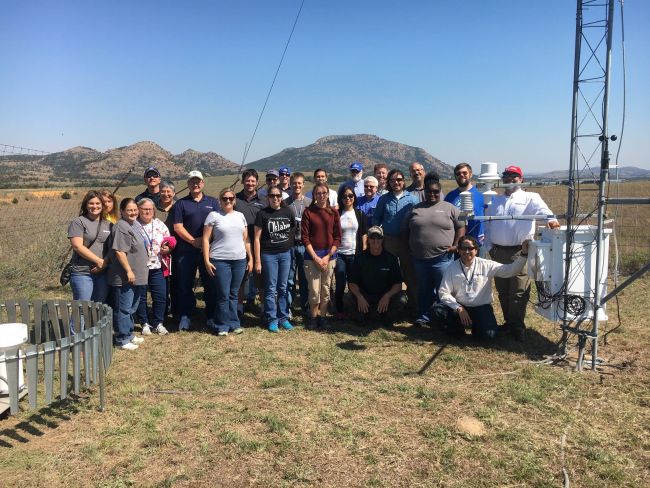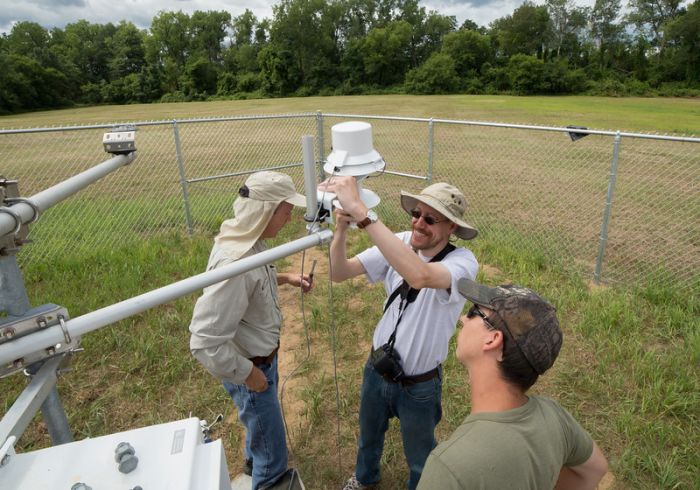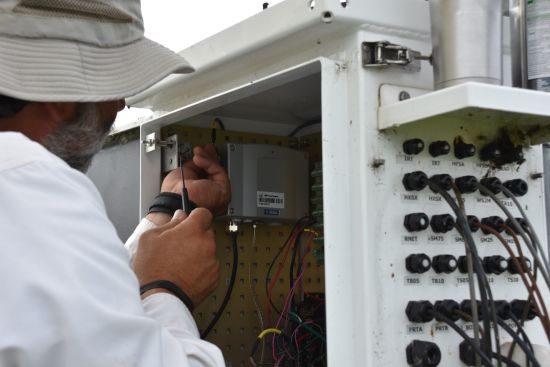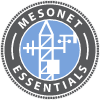Providing Staffing for Your Mesonet

(Photo courtesy of Dr. Christopher A. Fiebrich, Executive Director, Oklahoma Mesonet)
Your mesonet requires a team of staff members to handle many tasks, including the following:
- Designing your mesonet
- Installing the many automated weather stations of the network
- Making your mesonet fully operational
- Managing the daily operation and maintenance of your mesonet
Part of your budget for your mesonet includes paying these staff members who help make your mesonet successful. Determining which skill sets and how many staff members are needed will help you plan your budget.
In addition, consider how the funding of your staff members may differ. For example, some of your staff members may be university personnel with dual jobs who are paid by the university, whereas other members of your staff may be dedicated mesonet employees paid under mesonet-related funding.
Roles of Staff Members

(Photo courtesy of Dr. Christopher A. Fiebrich, Executive Director, Oklahoma Mesonet)
While every mesonet has different needs, the following are some common roles performed by mesonet staff members:
- Calibration (for sensor calibrations and repairs)
- Data services (such as filling data requests, working with media)
- Field operations (for example, vegetation and electronics/communications technicians)
- Monitoring and quality assurance (including technician support to routinely review weather station data)
- Outreach (for topics such as public safety, K-12, agriculture, fire)
- Research
- Software development (to manage websites, databases, models, apps, etc.)
- System administration
These roles may be fulfilled by a staff with a variety of backgrounds: scientist, engineer, administrator, professor, student, or technician. In addition, you may choose to hire contractual engineers for the initial deployment and permanent staff members to fulfill the other roles.
Another method to determine your staffing needs is to group the roles into larger categories:
- Hardware
- Software
- Support
Hardware
You will need a team of engineers and technicians to maintain your system hardware. This includes all aspects of the hardware, such as system power, communications, the data logger, and sensors. Trained technical staff members are key to the long-term maintenance needs and success of your mesonet, as they need to handle onsite maintenance and repairs to stations. A technician typically has a unique set of focused skills related to instrumentation, electronics, and software. In addition, it is advantageous to have a staff member with a strong background in the type of parameters you're measuring and the type of data you're collecting. For example, it would be appropriate to have a meteorologist on staff for a meteorological mesonet.
Software
Software engineers and programmers develop and maintain the system networking, servers, databases, software development, quality control, and your user interface (such as a website). These staff members help ensure you continue to deliver your mesonet deliverables to your stakeholders.
Support
Support staff members are needed to perform a variety of tasks related to finance, administration, and facilities. Some task examples include budgeting, overseeing equipment purchases, staff scheduling, development of collaborations and external partnerships, site permitting, and working with site hosts and customers. These staff members can help smooth relationships with your stakeholders and the general public, as well as ensure that your mesonet funding continues. Because many mesonets are operated by universities or government agencies, many of these tasks are handled by those entities.
Size of Your Staff
After reviewing the many roles that your staff must fulfill to help make your mesonet successful, you may wonder how large of a staff you need to hire. The number of staff members varies from mesonet to mesonet. For example, small to medium networks may have as few as three staff members, whereas a network with more than 100 stations may have has many as 20 staff members.
Although some mesonets discover that the size of their staff may be more a function of their budget than the actual size of their network, a general guideline is that the larger your network, the greater your need for financial support and, therefore, the greater your need for a larger staff.
At a bare minimum, you will need to ensure these roles are filled:
- Director/program manager
- Hardware technician
- Software engineer
- Field technician
The Oklahoma Mesonet shared the details of their staffing needs for the management of their network of 120 stations:
- 3 electronics/communications technicians
- 1 vegetation technician
- 2 calibration technicians
- 1 data services specialist
- 2 system administrators
- 2 researchers
- 2 monitoring and QA specialists
- 1 outreach specialist for public safety
- 1 outreach specialist for fire
- 1 outreach specialist for agriculture
- 1 outreach specialist for K-12
- 8 software developers

Tip: It may be better to have your IT and development work done by someone who has a science background rather than by an IT specialist without a science background.
While it may be an attractive thought to have a single staff person fill multiple roles, care should be taken to ensure that you are not spreading your staff too thinly and thus compromising the meeting of your mesonet objectives. At the same time, the mesonet deliverables for your stakeholders should be proportional to the size of your staff to prevent a scenario of overpromising and underdelivering.
If your mesonet deliverables include providing data for use in emergency management operations, ensure that you are adequately staffed. It may be necessary to have a staff member on standby during weekends, holidays, and evenings.
Working Together to Meet Your Mesonet Objectives
No matter what the size of your staff, your staff members should work well together so that all necessary roles are filled without duplication of effort. Staff members should understand their roles and how their efforts interplay with the work of other staff members. Weekly staff meetings can be helpful for coordination, and you may find that having team leaders for various roles helps your staff members remain focused.
The following example illustrates how staff members may work together on a data issue:
- The quality control (QC) team diagnoses data issues either via the automated QC software or a manual review of the data.
- The QC team alerts the hardware team that a problem exists at a specific site or that there is a network-wide problem.
- If the problem is software related, the software team is alerted.
- After a sensor is brought in from the field, additional technicians clean, repair, and calibrate the sensor.
Finding Staff Members

Finding staff members for your mesonet may sound like a daunting task. The following are some tips to help you:
- When you post a position on a university's job website, the position is often then published on various job sites.
- Indeed (indeed.com/) may help you find candidates more targeted to your needs.
- Targeted job websites and listservs may help you find candidates with your needed skill sets.
- For meteorological technical positions, consider posting on the American Meteorological Society and National Weather Association websites.
- For developer and IT roles, consider using your local university's job website and local job sites for professionals.
- For positions suitable for early-career professionals, consider sending advertisements to academic programs that may have interested graduates.
Finding a suitable technician

While it is important to hire staff members who are well-suited to the positions and will work well together as a team, hiring a technician may be especially challenging. You may wonder what qualities you should look for. The following are some suggested qualities:
- Detail oriented, organized, and proficient at communicating
- Some background working with environmental sensors or, at least, some experience working with electronics
- Comfortable being outside, doing field work, and getting dirty
- Preferably, some experience working in the field such as climbing and lifting
The sample job postings that follow are intended to help you write your own jobs postings to meet the specific needs of your mesonet.
Sample Kentucky Mesonet job posting
Primary Duties and Responsibilities:
- Traveling to remote sites, sometimes requiring overnight stays
- Troubleshooting and repairing/replacing failed sensors and electronic equipment at Mesonet sites on a deadline basis
- Operating power equipment to maintain site vegetation
- Performing on-site calibrations of sensors at Mesonet observing sites
- Calibrating instruments in Mesonet laboratories
- Submitting paperwork and digital metadata on a deadline basis to document sensor problems and site conditions/inspections
- Installing and testing sensors and electronic equipment at new Mesonet sites
- Serving as a point of contact and interacting with site hosts, local media, partners, and users regarding Mesonet operations, research, and outreach
- Developing, either individually or as a team member, research proposals and projects utilizing Mesonet data
- Accessing Mesonet and complementary databases to assimilate data in support of research
- Using statistical and/or geographic information systems software to analyze, display, and/or interpret Kentucky Mesonet data
- Representing the Kentucky Mesonet at professional meetings and trade shows
- Taking on additional duties as needed
Knowledge and Skills Considered Essential for Success:
- Knowledge of mesoscale meteorology and climatology
- Knowledge of meteorological instrumentation and equipment for automated environmental monitoring, including testing and calibration procedures
- Knowledge and skills involving data analysis and visualization using statistical and/or geographic information systems software
- Troubleshooting and problem-solving skills
- Scientific and technical writing skills
- Interpersonal communication and public speaking skills
Requirements:
- Bachelor's degree in meteorology or related discipline
- Valid Class D driver's license
- Availability to work a flexible schedule that occasionally includes overnight travel
- Ability to lift and carry heavy objects (45 pounds and over)
- Ability to climb, including ladders and communications towers (up to 30 feet) where agility or balance is an issue
- Ability to work outdoors with regular exposure to Kentucky weather
Sample Nebraska Mesonet job posting
Bachelor’s degree in electronic technology, meteorology, or closely related field plus one year of experience working with data collection devices, measurement sensors, and installation of field monitoring equipment; equivalent education/experience considered. Knowledge of and abilities to manage data logging equipment. Familiarity with weather data and communication devices. Experience must demonstrate good communication and organizational skills. Ability to work independently and as a member of a team necessary. Experience working with meteorological instrumentation, wireless communications, and environmental monitoring. Knowledge and skills specific to data loggers and software. Knowledge of weather station site survey techniques and skilled with microclimate sensors. Ability to design and fabricate circuits and weather station data collection paradigms, including support structures.
Sample Oklahoma Mesonet job posting
The Technician will be responsible for the installation, maintenance, and repair of weather monitoring and communications sites across the state of Oklahoma by performing tasks to include:
- Being responsible for both the routine and emergency maintenance of ~40 weather monitoring stations and ~30 communications sites;
- Troubleshooting and repairing/replacing failed sensors, electronic and communications equipment on a time sensitive basis;
- Replacing sensors and equipment on a routine basis that have reached the end of their rotation schedule;
- Upgrading equipment and sensors;
- Performing on-site calibrations of sensors in the field;
- Submitting digital metadata on a time sensitive basis to document sensor problems and site maintenance;
- Installing new weather stations;
- Traveling to remote sites sometimes requiring overnight stays;
- Assisting fellow technicians with special projects in their maintenance areas;
- Working with and submitting reports to agencies outside of OCS;
- Operating a Mesonet vehicle in a safe and courteous manner; and
- Operating power equipment to maintain site vegetation.
Required Education:
Associate degree or 2 years college study completed in Engineering, Electronics, Meteorology, or a related technical field or an equivalent combination of education and related experience.
- 30 months experience in Engineering, Electronics or Meteorology
Skills:
- 12 months experience with computer software (e.g., Microsoft Windows, Microsoft Office, Apple iOS);
- Strong attention to detail;
- Ability to work with a team to solve challenging problems; and
- Ability to work with minimal supervision.
Certifications:
- Valid Class D driver's license, clean driving record, and ability to drive for long periods of time
Advertised Physical Requirements:
- Ability to work outdoors in varying and extreme weather conditions;
- Ability to lift and carry heavy objects (45 pounds and over);
- Ability to climb including ladders and communications towers (up to 100 feet) where agility or balance is an issue;
Department Preferences:
- 12 months experience in remote weather station maintenance;
- 24 months experience with communications technology (VHF, Wi-Fi, cellular);
- Bachelor’s degree in Engineering, Electronics, or Meteorology;
- Familiarity with Oklahoma Mesonet data;
- Experience and proficiency using interactive web pages and utilizing remote servers;
- Experience in instrumentation interface software and dataloggers; and
- Experience with or education in meteorological data analysis or instrumentation.
